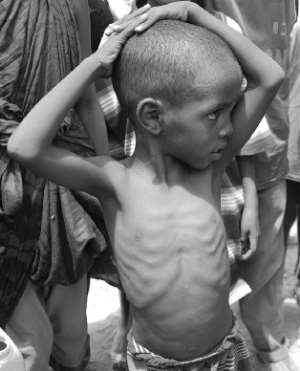
Nutrition is the science that interprets the relationship of foods to the functioning of a living organization. Malnutrition is defined as the lack of adequate nourishment.
Malnutrition remains one of the most common causes of morbidity and mortality among children throughout the world. Approximately 9% of children below 5 years of age suffer from wasting and are at risk of death or severe improvement of growth and psychological development.
In 2008, of the 8.8 million global deaths of children fewer than 5 years of age, 93% occurred in the developing countries of Africa and asia and over a third of all deaths can be attributed to underlying malnutrition.
Childhood malnutrition
•Protein Energy malnutrition[PEM]: This is caused by a deficiency intake of energy and usually protein. Secondary PEM can result as a result of other complications like AIDS, chronic kidney failure, inflammatory bowel disease and other illnesses that impair the body ability to absorb or utilize nutrients.
CAUSES
•Poverty
•War and famine which oftentimes make food unavailable
•Ignorant on the nutrient requirement for children
•Poor living conditions leading to the consultation of contaminated foods and subsequent exposure to infection frequently.
SIGNS
•Muscle wasting
•The belly may look prominent
•The skills develop more slowly
The more severe ones are marasmus, kwashiorkor, marasmic kwashiorkor, and iron deficiency anaemia
Marasmus: This is a severe form of protein-energy malnutrition that results when a person does not consume enough protein and calories . Without these vital nutrients, energy levels become dangerously low and vital functions begin to stop.
Both adults and children can have marasmus, but it most often affects young children in developing countries.
Causes of marasmus include:
not having enough nutrition or having too little food
consuming the wrong nutrients or too much of one and not enough of another
having a health condition that makes it difficult to absorb or process nutrients correctly
The primary symptom of marasmus is an acute loss of body fat and muscle tissues, leading to an unusually low body mass index (BMI). Marasmus is a type of wasting.
In a child, the main symptom of marasmus is a failure to grow, known as stunted growth.
In adults and older children, the main symptom may be wasting, or a loss of body tissue and fat. An older child with wasting may have standard height for their age.
A child with marasmus may also be very hungry and suck on their clothes or hands as if looking for something to eat.
But some people with marasmus will have anorexia, and they will not want or be able to eat.
Kwashiorkor
Kwashiorkor is another severe form of protein-energy malnutrition where the main deficiency is protein.
Severe cases of malnutrition can lead to kwashiorkor. Unlike marasmus, kwashiorkor causes the body to retain fluid in the lower legs, feet, arms, hands, and face, leading to a swollen appearance.
Kwashiorkor may also result in a person having a distended or bulging abdomen. But, someone with kwashiorkor may not have a particularly low weight, because the fluid buildup makes up for the loss in body fat and muscle tissue.
Marasmic kwashiorkor
Marasmic kwashiorkor is the third form of protein-energy malnutrition that combines features and symptoms of both marasmus and kwashiorkor.
Poor sanitation and hygiene can lead to infections that can worsen the symptoms of marasmus and other types of malnutrition and make it harder to recover.
Cooking foods at high heat to destroy bacteria can help, as can freezing food and reheating it before eating.
Boiling water before drinking, cooking, or bathing in areas where clean water is difficult to access is essential to prevent spreading waterborne diseases.
Breastfeeding infants for 6 months can help protect them from nutritional difficulties, especially in places where food is short.
Abdulkareem Taoheedah kehinde




 There’s nothing you can do for us; just give us electricity to save our collapsi...
There’s nothing you can do for us; just give us electricity to save our collapsi...
 Ghanaian media failing in watchdog duties — Sulemana Braimah
Ghanaian media failing in watchdog duties — Sulemana Braimah
 On any scale, Mahama can't match Bawumia — NPP Youth Organiser
On any scale, Mahama can't match Bawumia — NPP Youth Organiser
 Never tag me as an NPP pastor; I'm 'pained' the 'Akyem Mafia' are still in charg...
Never tag me as an NPP pastor; I'm 'pained' the 'Akyem Mafia' are still in charg...
 Your refusal to dedicate a project to Atta Mills means you never loved him — Kok...
Your refusal to dedicate a project to Atta Mills means you never loved him — Kok...
 2024 elections: I'm competent, not just a dreamer; vote for me — Alan
2024 elections: I'm competent, not just a dreamer; vote for me — Alan
 2024 elections: Forget NPP, NDC; I've the Holy Spirit backing me and nothing wil...
2024 elections: Forget NPP, NDC; I've the Holy Spirit backing me and nothing wil...
 2024 elections: We've no trust in judiciary; we'll ensure ballots are well secur...
2024 elections: We've no trust in judiciary; we'll ensure ballots are well secur...
 Performance tracker: Fire MCEs, DCEs who document Mahama's projects; they're not...
Performance tracker: Fire MCEs, DCEs who document Mahama's projects; they're not...
 Train crash: Railway ministry shares footage of incident
Train crash: Railway ministry shares footage of incident
